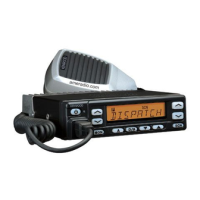10
TK-863G
REALIGNMENT
5-4. Programming Software Description
The KPG-76D programming disk is supplied in 3-1/2" disk
format. The software on this disk allows a user to program
TK-863G radio via a programming interface cable (KPG-46).
5-5. Programming With IBM PC
If data is transferred to the transceiver from an IBM PC
with the KPG-76D, the destination data (basic radio informa-
tion) for each set can be modified. Normally, it is not neces-
sary to modify the destination data because their values are
determined automatically when the frequency range (fre-
quency type) is set.
The values should be modified only if necessary. Data
can be programmed into the flash memory in RS-232C for-
mat via the modular microphone jack.
6. Firmware Programming Mode
6-1. Preface
Flash memory is mounted on the TK-863G. This allows
the TK-863G to be upgraded when new features are re-
leased in the future. (For details on how to obtain the firm-
ware, contact Customer Service.)
6-2. Connection Procedure
Connect the TK-863G to the personal computer (IBM PC
or compatible) with the interface cable (KPG-46). (Connec-
tion is the same as in the PC Mode.)
6-3. Programming
1. Start up the programming software (FPRO EXE.).
2. Set the communications speed (normally, 57600 bps)
and communications port in the Setup item.
3. Set the firmware to be updated by file name item.
4. Turn the TK-863G Power ON with the [
] switch held
down. Hold the switch down for two seconds until the
display changes to “PROG 576”, the BUSY/TX LED lights
orange. When “PROG 576” appears, release your finger
from the switch.
5. Check the connection between the TK-863G and the per-
sonal computer, and make sure that the TK-863G is in
Program mode.
6. Click write button in the window. A window opens on
the display to indicate the writing progress. When the
TK-863G starts to receive data, the BUSY/TX LED lights
green.
7. If writing ends successfully, the LED on the TK-863G
goes off and the checksum is displayed.
8. If you want to continue programming other TK-863G, re-
peat steps 4 to 7.
Notes :
• This mode cannot be entered if the Firmware program-
ming mode is set to Disable in the Programming soft-
ware (KPG-76D).
• When programming the firmware, it is recommend to
copy the data from the floppy disk to your hard disk be-
fore you update the radio firmware.
Directly copying from the floppy disk to the radio may not
work because the access speed is too slow.
4. Radio Information
Executing this function, “–PC–” apears on the display of
the TK-863G while calculation the check sum.
When the calculation is completed, the display returns to
normal and PC displays the check sum of the radio.
5. PC Mode
5-1. Preface
The TK-863G transceiver is programmed using a personal
computer, a programming interface (KPG-46) and program-
ming software (KPG-76D).
The programming software can be used with an IBM PC
or compatible. Figure 1 shows the setup of an IBM PC for
programming.
5-2. Connection Procedure
1. Connect the TK-863G to the personal computer with the
interface cable.
2. When the Power is switched on, user mode can be en-
tered immediately. When the PC sends a command, the
radio enters PC mode.
When data is transmitted from transceiver, the red LED
blink.
When data is received by the transceiver, the green LED
blink.
Notes :
• The data stored in the personal computer must match
model type when it is written into the flash memory.
• Change the TK-863G to PC mode, then attach the inter-
face cable.
5-3. KPG-46 Description
(PC programming interface cable : Option)
The KPG-46 is required to interface the TK-863G to the
computer. It has a circuit in its D-subconnector (25-pin) case
that converts the RS-232C logic level to the TTL level.
The KPG-46 connects the modular microphone jack of
the TK-863G to the computers RS-232C serial port.
KPG-46
IBM-PC
KPG-76D
TK-863G
Fig. 1

